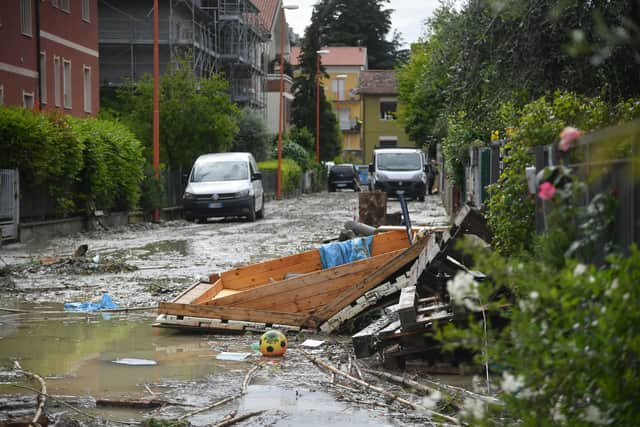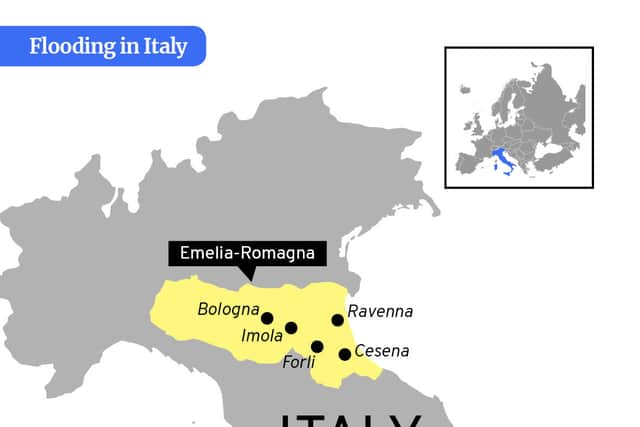Italy and Croatia flooding: which areas have been hit hardest by deadly floods and is it safe to travel there?
and live on Freeview channel 276
Heavy rainfall and dangerous flooding across Italy and Croatia has devastated residents of a number of popular tourist hotspots in the Southern European countries.
Flash flooding in the southern Italian province of Avellino on Thursday 25 May killed one man and destroyed building and roads. The flooding came after heavy rainfall and dangerous conditions in the north of the country in the Emilia-Romagna region.
Advertisement
Hide AdAdvertisement
Hide AdItaly had recorded 15 deaths in the region as of 25 May, after the downpour caused landslides and road closures in regions across both of the two countries. The floods are the worst in the past 100 years for the country, with scientists pointing towards the country's vulnerability to climate change as the reason for the devastation.
The Italian Grand Prix was cancelled following the extreme weather, and local authorities say the deluge has likely caused billions of euros in damages. Clean-up work is now getting underway, with rescue crews working to reach towns and villages in northern Italy, which have been cut off from motorways, electricity and mobile phone service.
Both Italy and Croatia are popular destinations for tourists heading into the warmer months. However, in the aftermath of the intense floods, are they still safe to travel to?
Here's everything you need to know about the latest travel advice for the regions.


Is it safe to travel to Italy and Croatia?
Advertisement
Hide AdAdvertisement
Hide AdAs of 26 May, advice from the Foreign, Commonwealth & Development Office (FCDO) currently states that travellers around the Emilia-Romagna region of Italy should take caution. It is not recommended that trips should be cancelled, however those visiting the region should follow the advice of local authorities and check with your accommodation provider before travelling.
The FCDO has also said that those travelling to the Emilia-Romagna region may be hit by heavy traffic as the flooding led to the closure of roads, particularly between Bologna and Rimini. Visitors are also advised to stay away from riverbanks and green areas hit by the heavy rain.
Additional travel advice for the flooding in Croatia has not been given by the FCDO. Caution should be taken when travelling in the affected areas, but as of yet, there is no advice against travelling to the country.
Where are the worst of the floods?
Heavy rainfall fell on the Emilia-Romagna region of Italy, with cities such as Bologna and Imola affected by the floods. Stefano Bonaccini, president of the region, said that “extraordinary amounts of rain have fallen on land no longer capable of absorbing them”.
Advertisement
Hide AdAdvertisement
Hide AdThe region has been washed out, with rivers bursting their banks and dangerous landslides pushing out residents. Civil Protection Minister Nello Musumeci said that in some areas, half of its overall annual rainfall fell within 36 hours.
A total of nine people have died due to the heavy rainfall. It follows the death of two people earlier in the month in the Emilia-Romagna region amid bad storms.


By Thursday morning, some parts of the city of Faenza were still underwater, with cars submerged and basements flooded with thick mud. One family standing on their balcony told Associated Press reporters they did not have electricity, gas or food.
More than 10,000 people have fled their homes, some plucked from rooftops or balconies by rescue helicopters and others ferried out on civil protection dinghies. One family with a 20-day-old baby was rescued on Thursday morning, said Cesena mayor Enzo Lattuca.
Advertisement
Hide AdAdvertisement
Hide AdThe Italian Grand Prix in Imola was cancelled due to the flooding. The event was to take place this weekend, but organisers have called it off in an attempt to relieve pressure on emergency services in the region and to reduce large crowds gathering as a result.
In Croatia, a state of emergency has been declared in the central and south-eastern areas of Karlovac and Kostajnica. The Kupa and Korana rivers have burst their banks, with the River Una also overflowing.
Heavy rainfall has also hit other regions of Croatia, including Varazdin County and the Zadar region. Croatian Prime Minister Andrej Plenkovic pledged financial support to residents in the areas affected by flooding.
What are the ongoing impacts of the flooding likely to be?
Italian farmers have warned of “incalculable” losses, as authorities begin mapping out clean-up and reconstruction plans.
Advertisement
Hide AdAdvertisement
Hide AdStefano Bonaccini said the losses now reached multiple billions given the widespread damage to farmland, shopfronts and infrastructure from this week’s flooding.
Italian farm lobby Coldiretti said more than 5,000 farms with greenhouses, nurseries and stables have been flooded, covering thousands of acres of vineyards, fruit groves, vegetables farms and grain fields. It said the flooding may impact future harvests in years to come - with the “suffocating” muddy runoff causing permanent damage to roots.
The drought-parched region had already suffered an estimated one billion euros (£870 million) in losses from heavy rains earlier this month.
Comment Guidelines
National World encourages reader discussion on our stories. User feedback, insights and back-and-forth exchanges add a rich layer of context to reporting. Please review our Community Guidelines before commenting.